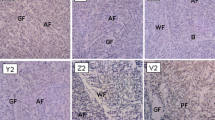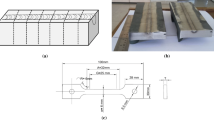Abstract
The transformation behaviour of C-Mn-Ti alloyed steel weld metals with different levels of nitrogen and boron contents has been investigated using a dilatometric technique in combination with transmission electron microscopy (TEM) associated with microanalysis techniques, i.e. energy dispersive X-ray analysis (EDXA) and electron energy loss spectroscopy (EELS) in order to clarify the role of nitrogen and boron on the nucleation and growth processes of weld metal microstructure in particular acicular ferrite which gives high strength and improved impact toughness of steel weld metals. Results of this investigation showed that the addition of a small amount of boron, typically 40 ppm to a C-Mn-Ti weld metal was sufficient to significantly reduce the transformation start temperature with a decrease in the amount of grain boundary ferrite and a concommittant rise in the amount of acicular ferrite. Further decrease in the transformation start temperature was observed as the level of boron content was increased up to approximately 160 ppm resulting in the formation of bainitic microstructures. However, a subsequent addition of nitrogen around 240 ppm to this type of weld metal increased the transformation temperature and modified the weld microstructure marked by the presence of intragranular acicular ferrite and polygonal ferrite which nucleated on multiphase inclusions principally of the ‘TiO’ type but on which has formed BN. This finding seems to suggest that BN is a potent substrate for nucleating ferrite and the amount of acicular ferrite in Ti-B-N system is controlled by the balance between BN as an energetically favourable site for acicular ferrite nucleation and soluble boron which acts as a hardenability element suppressing grain boundary ferrite formation.
Similar content being viewed by others
References
Garland J.G. and Kirkwood P.R.: Towards improved submerged-arc weld metal, Metal Construction, 7(5), 1975, pp. 275 and (6), pp.320.
Levine E. and Hill D.C.: Toughness in HSLA steel weldments, Metal Construction, 9(8), 1977, pp. 346.
Evans G.M. and Baley N.: Metallurgy of basic weld metal, Abington Publishing and William Andrew Inc., England, 1977, pp. 306.
Croft N.H. and Hipley R.L.: Microstructure and properties of heat treated weldments, Int. Conf.: The effects of residual, impurity and microalloying elements on weldability and weld properties, Paper 26, London, 1983.
Lau T.W, Sadowski M.M., North T.H., and Weatherly G.C.: Effect of nitrogen on properties of submerged arc weld metal, Material Science and Technology, (4), 1988, pp. 53-61.
Yamada T., Terasaki H. and Komizo Y.: Relation between inclusion surface and acicular ferrite in low carbon low alloy steel weld, ISIJ International, vol.49, 2009, No. 7, pp. 1059–1062.
Koshio K., Ootawa M., Tonigaki T., Takino Y., Horii Y., Tsynetomi E. and Imai K.: Development of the high titanium boron bearing covered electrode, IIW Doc. II-955-81, 1981.
Evans G.M.: Effect of nitrogen on C-Mn steel welds containing titanium and boron, Welding Journal, vol. 75, 1996, pp. 251–260s.
ISO 2560-1973: Covered electrodes for manual arc welding of mild and low alloy steel-Code of symbols for identification.
Mori N., Homma H., Okia S. and Asano K.: The behaviour of B and N in notch toughness improvement in Ti-B weld metals, IIW/ISS-IX-1158-80.
Lee H.W., Kim Y.H., Lee S.H., Lee S.K., Lee K.H., Park J.U. and Sung J.H.: Effect of boron contents on weldability in high strength steel, Journal of Mechanical Science and Technology, 21, 2007, pp. 771–777.
Babu S.S., Goodwin G.M., Rohde R.J. and Sielen B.: Effect of boron the microstructure of low carbon steel resistance-seam welds, Welding Journal, 77, 1998, pp. 249–253.
Porter D.A. and Easterling K.E.: Phase transformations in metals and alloys, Chapman and Hall, London, 1992.
Reed-Hill R.E., and Abbaschian R.: Physical Metallurgy Principles, PWS Publishing Company, 3rd ed, Boston, USA, 1995.
Verhoeven J.D.: Fundamentals of Physical Metallurgy, John Willey & Sons, New York, 1975
Thewlis G.: Transformation kinetics of ferrous weld metal, Materials Science and Technology, 10, 1994, pp. 110–125.
Oldland R.B.: The influence of aluminium and nitrogen on the microstructures and properties of single pass submerged arc welds, Australian Welding Research, 1985, 44-56.
Mills A.R., Thewlis G. and Whiteman J.A.: Nature of inclusions in steel weld metals and their influence on formation of acicular ferrite, Materials Science and Technology, 3, 1987, pp. 1051–1061.
Jang J. and Indeacochea J.E. J.: Inclusion effects on submerged arc weld microstructure, Journal of Materials Science, 22, 1987, pp. 689–700.
Grong O. and Matlock D.K.: Microstructure development in mild and low alloy steel weld metals, International Metal Reviews, 31, 1986, pp. 27–48.
Yamanaka K. and Ohmori Y.: Effect of boron on transformation of low carbon low alloy steels Transactions ISIJ, 17, 1977, pp. 93–101.
Ohmori Y.: Isothermal decomposition of an Fe-C-B austenite, Transactions ISIJ, 11, 1971, pp. 339–348.
Watanabe S. and Ohtani H.: Precipitation behaviour of boron in high strength steel, Transactions ISIJ, 23, 1983, pp. 38–42.
Ohmori Y. and Yamanaka K.: Hardenability of borontreated low carbon low alloy steel, in Boron in Steel, Wisconsin AIME, 1979, pp. 44-60.
Maitrepierre Ph., Thivellier D. and Tricot R.: Influence of boron on the decomposition of austenite in low carbon alloyed steels, Metallurgical Transactions, 6A, 1975, pp. 287–301.
Melloy G.F., Silmmon P.R. and Podgursky P.P.: Optimizing the boron effect, Metallurgical Transactions, 4, 1973, pp. 2279–2289.
Matrepierre Ph., Rofes-Vernis J. and Thivellier D.: Hardenability concepts in the application to steel, AIME, 1978, pp. 421-447.
Jung J.G., Kim J., Noh K.M., Park K.K. and Lee Y.K.: Effects of B on microstructure and hardenability of resistence seam welded HSLA linepipe steel, Science and Technology of Welding and Joining, 17, 2012, No. 1, pp. 77–84.
Fountain R.W. and Chipman J.: Transactions AIME, 224, 1962, pp. 559.
Oikawa K. and Ishida K.: Effect of titanium addition on the formation and distribution of MnS inclusions in steel during solidification, Transactions ISIJ, 37(4), 1997, pp. 332–338.
Author information
Authors and Affiliations
Corresponding author
Additional information
British Steel Professor of Ferrous Metallurgy
Oerlikon Industries Gmbh
Rights and permissions
About this article
Cite this article
Ilman, M.N., Cochrane, R.C. & Evans, G.M. Effect of Nitrogen and Boron on the Development of Acicular Ferrite iN Reheated C-Mn-Ti Steel Weld Metals. Weld World 56, 41–50 (2012). https://doi.org/10.1007/BF03321394
Published:
Issue Date:
DOI: https://doi.org/10.1007/BF03321394




